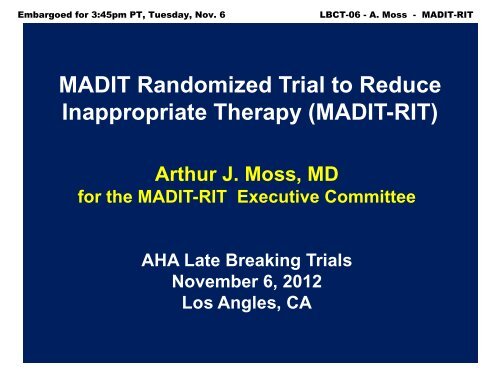MADIT Randomized Trial to Reduce Inappropriate Therapy ... - 1
MADIT Randomized Trial to Reduce Inappropriate Therapy ... - 1
MADIT Randomized Trial to Reduce Inappropriate Therapy ... - 1
- No tags were found...
Create successful ePaper yourself
Turn your PDF publications into a flip-book with our unique Google optimized e-Paper software.
<strong>MADIT</strong> <strong>Randomized</strong> <strong>Trial</strong> <strong>to</strong> <strong>Reduce</strong><strong>Inappropriate</strong> ate <strong>Therapy</strong> (<strong>MADIT</strong>-RIT)Ath Arthur J. Moss, MDfor the <strong>MADIT</strong>-RIT Executive CommitteeAHA Late Breaking <strong>Trial</strong>sAHA Late Breaking <strong>Trial</strong>sNovember 6, 2012Los Angles, CA
DISCLOSURE INFORMATIONArthur J. Moss, MDCompanyBos<strong>to</strong>n ScientificRelationshipResearch GrantHold no s<strong>to</strong>ck or s<strong>to</strong>ck options in anydevice company. Not a member of anycorporate advisory group or speakers’bureau.
<strong>MADIT</strong>-RIT: BACKGROUND• ICD is highly effective in reducing mortality inhigh-risk cardiac pts.• Despite sophisticated device-detectionalgorithms, 8-40% of ICD therapies areinappropriate with adverse side effects• Question: can ICD devices be reprogrammed<strong>to</strong> safely reduce inappropriate therapies?
<strong>MADIT</strong>‐RIT: HypothesisHypothesisDual-chamber ICD or CRT-D devices with:- high-rate cu<strong>to</strong>ff (>200bpm), or- duration-delay (initial 60sec moni<strong>to</strong>ring delay@>170bpm) plus rhythm ID detectiontiwill be associated with fewer 1 st inappropriatetherapies than standard/conventionalprogramming (2.5sec delay @ >170bpm)without increase in mortality<strong>Randomized</strong>, 3-arm study using Bos<strong>to</strong>n Scientific<strong>Randomized</strong>, 3 arm study using Bos<strong>to</strong>n Scientificdevices
<strong>MADIT</strong>-RIT: Three Treatment Arms*Randomization Arm Bi ArmsC(Conventional)Arm A(High-rate)Zone 1: Zone 1: Zone 1:(Duration-delay)>170 bpm, 2.5s delay 170 bpm >170 bpm, 60s delayOnset/Stability DetectionEnhancements ONATP + ShockMoni<strong>to</strong>r onlyRhythm ID DetectionEnhancements ONATP + ShockZone 2: Zone 2: Zone 2:>200 bpm, 1s delay >200 bpm, 2.5s delay >200 bpm, 12s delayQuick Convert ATPShockQuick Convert ATPShock* All programming is within approved labelingRhythm ID DetectionEnhancements ONATP + ShockZone 3 :>250 bpm, 25 2.5s delayQuick Convert ATP + Shock
<strong>MADIT</strong>-RIT: ELIGIBILITYInclusion Criteria- I 0 prevention patients t with no Hx of VT/VF- Sinus rhythm at enrollment; Hx PAF ok- Pt. on stable, optimal pharmacologic therapy-Age >21 yrs; informed consentExclusion Criteria- Pt. with pacemaker, ICD or CRT-D device- CABG or PTCA in past 3 months- MI (enzyme +) or AF in past 3 months- 2 nd or 3 rd degree heart block-NYHA IV- Chronic AF- Renal disease:BUN>50mg/dlor Creatinine>2.5mg/dL
<strong>MADIT</strong>-RIT: <strong>MADIT</strong>-RIT Prespecified PrimaryEnd PointsEndpointPRIMARY (90% power for hazard ratio 0.5 at p
<strong>MADIT</strong>-RIT: POPULATION• 1,500 pts. enrolled from 98 centersin US, Canada, Europe, Israel & Japan• Average follow-up = 1.4 years
Baseline Demographic and ClinicalCharacteristics(no significant differences in 22 variables among the 3 Rx groups)Variable<strong>Therapy</strong> GroupA B CConventional High-rate Duration-delay>170bpm >200bpm >170bpm(n=514) (n=500) (n=486)Age, yrs 64 63 62Male, % 70 71 72Ischemic, % 53 54 52EF, % 26 26 26
Cumulative Probability of First <strong>Inappropriate</strong> <strong>Therapy</strong>y pp p pyby Treatment Group
Figure 2.Cumulative Probability of Death by Treatment Group
FREQUENCY AND HAZARD RATIOS FOR INAPPROPRIATE THERAPY,DEATH, AND SYNCOPE BY TREATMENT GROUPTreatmentGroupsTreatment Group ComparisonsEvents # of patients B vs. A C vs. AA B Cn=514 n=500 n=486HazardRatioP-valueHazardRatioP-valueFirst<strong>Inappropriate</strong>Rx105 21 26 0.21
Arrhythmias Triggering First<strong>Inappropriate</strong> TherapiesArrhythmiasTreatment t GroupA B C(# Pts. 1 st Inapp. Therapies)At Fib/Flut 24 11 5Regular SVT 78 9 17Other 3 1 4Note: marked reduction in patients with1 st inappropriate therapiesin High-rate (B) and Duration-delay (C) groups for At Fib/Flut andRegular SVT when compared <strong>to</strong> Conventional therapy (A).
Any Appropriate and <strong>Inappropriate</strong> <strong>Therapy</strong> byTreatment GroupTreatment t GroupP-valueA B C B v A C v An=514 n=500 n=486no. of patients (% of Rx group)Any Appropriate <strong>Therapy</strong>Shock 28 (5) 26 (5) 19 (4) 0.86 0.25ATP 111 (22) 38 (8) 20 (4)
<strong>MADIT</strong>-RIT: CONCLUSIONSImproved ICD programming at high-rate (>200bpm) or 60sec duration-delay is associated with:1) ~75% reduction in 1 st inappropriate therapy;2) ~50% reduction in all-cause mortalityWe believe the decrease in mortality is related <strong>to</strong>the reduction in adverse inappropriate i shock andATP therapies.
THANK YOU





